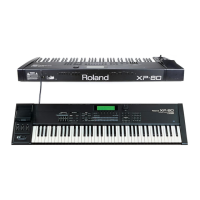178
This section discusses various techniques for effectively
using the XP-80 for specific applications. The more you use
the XP-80, the faster you’ll appreciate the real power of this
unit.
❚
Techniques for using Patches
Reinforcing filter characteristics
If you want to reinforce filter characteristics, set the Structure
Type 1&2 parameter (PATCH/Common/Structure) to 2, and
series-connect the TVFs of Tones 1 and 2.
This example shows how to boost the effectiveness of the fil-
ter for “PR-C:014 MKS-80 Brass.”
<Procedure>
❶ Select PR-C:014 MKS-80 Brass on the Play display
(PATCH).
❷ Press [FILTER/ENV] to light the indicator.
❸ Move the CUTOFF and RESO. sliders while you play
notes and hear how sound changes.
❹ Set the structure Type 1 & 2 parameter (PATCH/
Common/Structure) to 2.
❺ Again, move the CUTOFF and RESO. sliders and hear
how the sound changes. Notice the effectiveness of the
filter has changed.
✳ It might be easier to better hear note variations by
turning [EFX], [CHORUS] and [REVERB] off.
Making the up-beat note sound at the
same time you play a down-beat note
<Procedure>
❶ Select PR-A:087 Music Bells on the Play display
(PATCH) and listen to the sound.
❷ Call up the Wave Param display (PATCH/WG).
❸ Press TONE SELECT [1] to select Tone 1.
❹ Set Tone 1’s Mode parameter to PLAYMATE and the
Time parameter to 32.
❺ Play the XP-80’s keyboard keeping a constant tempo.
Tones 1 and 2 sound alternately. Tone 1 will sound at
the timing point exactly between a note you press and
the following note. Try various settings, for instance
use different wave or modify the pitch.
✳ Tone 1 will not sound if the two keys are pressed at an
interval of 2 seconds or longer.
Holding a note with modulation retained
In general, pressing the Hold pedal makes a note continue to
sound. However, other effects will go off. To keep other
effects effective as well, perform the following procedure.
<Procedure>
❶ Connect an optional pedal switch to the HOLD jack.
❷ Select a Patch (PR-C:110 Crash Pad, etc.) to which an
effect will be applied when the modulation lever is
moved on the Play display (PATCH).
❸ Set the Hold parameter (SYSTEM/Control/Control
Source) to HOLD-1.
❹ Call up the Common Control display (PATCH/
Common) and set Ctrl 1’s Peak&Hold to HOLD.
❺ Press a note and press the pedal switch as you move
the modulation lever forward.
❻ When the note and modulation lever are released, both
the note and the effect produced by the modulation
lever will be held.
Syncing the LFO cycle to sequencer tempo
<Procedure>
❶ Select PR-B:052 Blade Racer on the Play display
(PATCH).
❷ Set the Clock Source parameter (PATCH/Common/
Common General) to SEQUENCER.
❸ Make sure that each Tone’s EXT Sync parameter
(PATCH/LFO&Ctl/LFO1,2 Param) is set to CLK. If
not, reset.
❹ Press [SEQUENCER] to call up the Play display
(SEQ(Song)). Move the cursor to and try various
values as you press a note.
The Patch’s modulation tempo will also change in accor-
dance to the sequencer’s tempo clock.
❺ Set the modulation depth as desired using <Depth>
(PATCH/LFO&Ctl/LFO1,2 Param) of each Tone.
✳ When you have selected PR-B:47, 49, 51, 52–56, 69, PR-
C:34, 93, 97, 99, or 123, it is also possible to synchronize
the LFO to the sequencer’s tempo clock by setting the
Clock Source parameter (PATCH/Common/
Common General) to SEQUENCER. Try it.
Modifying EFX to match the tempo of a
song
<Procedure>
❶ Select PR-C:94 Albion on the Play display (PATCH).
❷ Set the Clock Source parameter (PATCH/Common/
Common General) to SEQUENCER.
❸ Make sure that the EFX Type parameter (PATCH/
Effects/General) is set to STEP-FLANGER. If not, reset.
❹ Make sure that the Step Rate parameter (PATCH/
Effects/EFX Param) is set as a note value. If not, reset
using a note value.
❺ Press [SEQUENCER] to call up the Play display
(SEQ(Song)).
❻ Move the cursor to and try various values while
you play the XP-80’s keyboard. You’ll notice that the
tempo of the Patch’s modulation changes in accor-
dance to the tempo clock of the XP-80’s sequencer.
You can modify EFX parameter values in accordance to the
sequencer’s tempo clock, when you have selected the follow-
ing types for the EFX Type parameter.
EFX Type EFX Parameter
16: STEP-FLANGER Step Rate parameter
19: TRIPLE-TAP-DELAY Delay Left–Right parameter
20: QUADRUPLE-TAP-DELAY Delay 1–4 parameter
✳ When you have selected PR-B:57, 65, 68, PR-C:94, 96,
and 98, it is also possible to sync the EFX parameter
variations of the sequencer’s tempo clock by setting the
Clock Source parameter (PATCH/Common/Common
General) to SEQUENCER. Try it and see.
Chapter 11. Getting the full potential of the XP-80
Chapter 11. Getting the full potential of the XP-80

